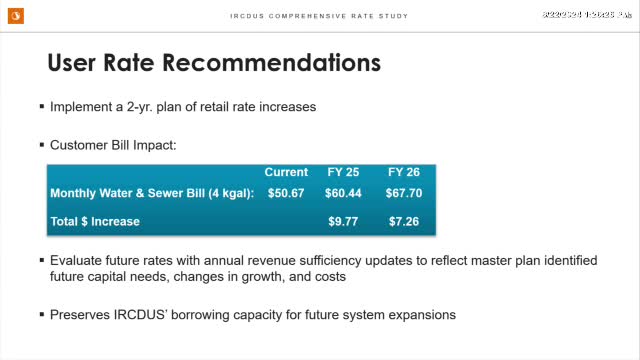Water rate plan promises lowest bills despite inflation pressures
August 22, 2024 | Indian River County, Florida
This article was created by AI summarizing key points discussed. AI makes mistakes, so for full details and context, please refer to the video of the full meeting. Please report any errors so we can fix them. Report an error »

In a recent government meeting, officials discussed the anticipated impacts of a new two-year rate plan for water and sewer services, projecting a modest increase in customer bills. For a typical user, the first year will see an increase of just under $1.10, followed by an additional rise of approximately $0.70 in the second year. This plan is part of a broader strategy that includes a forthcoming master plan aimed at identifying future capital needs and prioritizing investments in the aging infrastructure.
The officials emphasized the importance of waiting for the master plan findings before making any long-term adjustments beyond the two-year period. They aim to maintain a \"pay as you go\" approach to ensure financial stability while allowing for borrowing capacity for significant future expansions or rehabilitations.
Comparative analysis revealed that even with the proposed increases, the utility would still offer the lowest rates in the area. Other local utilities are also facing similar pressures, with some already planning rate increases due to inflation and regulatory requirements. For instance, Coco is considering a 2% increase next year, followed by a 4% increase the year after.
The meeting also highlighted the value of municipal water services, with officials presenting a cost comparison to illustrate the affordability of water. Filling a 10,000-gallon swimming pool with municipal water would cost around $50, while using bottled water would amount to approximately $10,000. This stark contrast underscores the economic advantage of municipal water, which is priced at $2.80 per 1,000 gallons.
Officials reiterated the importance of communicating this value to the community, noting that the cost of water remains significantly lower than many everyday grocery items. They also addressed the need for appropriate rates for various services, such as fire protection and septic tank disposal, to prevent shortfalls that could impact monthly water and sewer rates.
Overall, the discussions reflect a commitment to maintaining affordable utility rates while preparing for future infrastructure needs and ensuring the sustainability of essential services.
The officials emphasized the importance of waiting for the master plan findings before making any long-term adjustments beyond the two-year period. They aim to maintain a \"pay as you go\" approach to ensure financial stability while allowing for borrowing capacity for significant future expansions or rehabilitations.
Comparative analysis revealed that even with the proposed increases, the utility would still offer the lowest rates in the area. Other local utilities are also facing similar pressures, with some already planning rate increases due to inflation and regulatory requirements. For instance, Coco is considering a 2% increase next year, followed by a 4% increase the year after.
The meeting also highlighted the value of municipal water services, with officials presenting a cost comparison to illustrate the affordability of water. Filling a 10,000-gallon swimming pool with municipal water would cost around $50, while using bottled water would amount to approximately $10,000. This stark contrast underscores the economic advantage of municipal water, which is priced at $2.80 per 1,000 gallons.
Officials reiterated the importance of communicating this value to the community, noting that the cost of water remains significantly lower than many everyday grocery items. They also addressed the need for appropriate rates for various services, such as fire protection and septic tank disposal, to prevent shortfalls that could impact monthly water and sewer rates.
Overall, the discussions reflect a commitment to maintaining affordable utility rates while preparing for future infrastructure needs and ensuring the sustainability of essential services.
View full meeting
This article is based on a recent meeting—watch the full video and explore the complete transcript for deeper insights into the discussion.
View full meeting